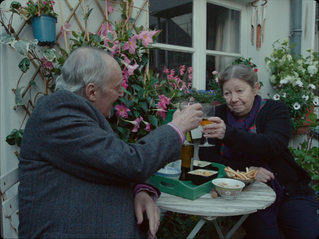Big Bang Big Boom
- Jonny Rogers
- Sep 7, 2021
- 3 min read
Blu, 2010

In an alternate universe (sometimes referred to as '2010'), the best videos on the internet took months to make, attempted something no one had done before, and nobody cared that they were only 360p.
Italian street artist Blu’s Big Bang Big Boom is one such video. As a follow up to his 2008 viral Muto, which combined street art with stop-motion animation in a 7½ minute surreal trip through Buenos Aires and Baden, Boom was even more ambitious in scale, attempting to offer its own account of evolutionary history.
The video starts in primordial blackness. Atomic compounds form simple bodies, which soon grow and contort, taking on new properties as they adapt to their environments. In one sequence, a chalk-drawn crab merges with a bucket as it chases a plastic bag; in another, a deflated ball drags itself across a beach with a pair of gloves.
The animation effortlessly traverses dimensional boundaries, as organisms seamlessly run between floors and walls and the underside of bridges; growing from a single brick to the entire face of a warehouse. This urban-industrial canvas is largely decrepit, dull, insipid, at least in contrast to the charming vitality of Blu’s creaturely designs.
Despite its often childish appearance, however, this world is deeply violent: life-forms cyclically hunt and consume others, as new beings emerge from their corpses. A shark begins to chase a fish, which then grows into a school that takes on the shape of a shark. An asteroid reduces dinosaurs to skeletal cages, and rats crawl out of their skulls. Each generation ends with death, but a death which nevertheless leads to birth, change, evolution - that is, until humans come into the picture.
Men emerge across the circumference of a giant silo, already armed with clubs, spears, bows and guns. One soldier fires a round that kills the first man, setting off a chain of reactions that lead to the death of all. As a nuclear missile erupts from a water cooling tower, the film culminates with an act of violence so great it can only be followed by silence.
Perhaps I am doing Blu a disservice by taking him too seriously. Like the Surrealists, his art seems to offer an aesthetic of free association as an antidote to the sober rationality that so readily justifies - or else remains ignorant to - its own evil.
Boom, as such, presents itself as a playful rebellion against the politics of ownership in an economy that rests on commodification, within which ideas, goods, and services are only valuable insofar as they might be bought or sold. Just as street artists aim to transform public spaces through adding image, text, and colour without authorised permission - and, for the most part, without financial incentive - Blu’s web videos proudly declare that anyone is ‘free to copy, distribute, display this work’ - but, crucially, ‘for non commercial purposes only’.
In fact, Blu is so committed to his open source philosophy that he chose to systematically destroy 20 years of his artwork in protest of an exhibition that would have taken his murals off the street. As he explains:
“We are faced with arrogant landlords who act as colonial governors and think they’re free to take murals off our walls… The only thing left to do is making these paintings disappear, to snatch them from those claws, to make hoarding impossible.”
We see a similar sentiment in Boom, for the film does not hide the scars of its impermanence. Shadows rapidly fall across the landscape, as pedestrians walk through the slow-moving epic that surrounds them. Each body is painted over and recreated in every frame, sometimes leaving a faint trace of its brief existence. What, then, will remain of us? In view of world-ending weaponry, the reality of our possible annihilation demands a transformation in how we relate to the world we inhabit.








Comments